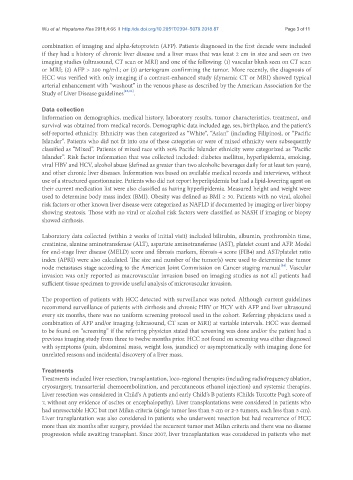Page 738 - Read Online
P. 738
Wu et al. Hepatoma Res 2018;4:66 I http://dx.doi.org/10.20517/2394-5079.2018.87 Page 3 of 11
combination of imaging and alpha-fetoprotein (AFP). Patients diagnosed in the first decade were included
if they had a history of chronic liver disease and a liver mass that was least 2 cm in size and seen on two
imaging studies (ultrasound, CT scan or MRI) and one of the following: (1) vascular blush seen on CT scan
or MRI; (2) AFP > 200 ng/mL; or (3) arteriogram confirming the tumor. More recently, the diagnosis of
HCC was verified with only imaging if a contrast-enhanced study (dynamic CT or MRI) showed typical
arterial enhancement with “washout” in the venous phase as described by the American Association for the
Study of Liver Disease guidelines [12,13] .
Data collection
Information on demographics, medical history, laboratory results, tumor characteristics, treatment, and
survival was obtained from medical records. Demographic data included age, sex, birthplace, and the patient’s
self-reported ethnicity. Ethnicity was then categorized as “White”, “Asian” (including Filipinos), or “Pacific
Islander”. Patients who did not fit into one of these categories or were of mixed ethnicity were subsequently
classified as “Mixed”. Patients of mixed race with 50% Pacific Islander ethnicity were categorized as “Pacific
Islander”. Risk factor information that was collected included: diabetes mellitus, hyperlipidemia, smoking,
viral HBV and HCV, alcohol abuse (defined as greater than two alcoholic beverages daily for at least ten years),
and other chronic liver diseases. Information was based on available medical records and interviews, without
use of a structured questionnaire. Patients who did not report hyperlipidemia but had a lipid-lowering agent on
their current medication list were also classified as having hyperlipidemia. Measured height and weight were
used to determine body mass index (BMI). Obesity was defined as BMI ≥ 30. Patients with no viral, alcohol
risk factors or other known liver disease were categorized as NAFLD if documented by imaging or liver biopsy
showing steatosis. Those with no viral or alcohol risk factors were classified as NASH if imaging or biopsy
showed cirrhosis.
Laboratory data collected (within 2 weeks of initial visit) included bilirubin, albumin, prothrombin time,
creatinine, alanine aminotransferase (ALT), aspartate aminotransferase (AST), platelet count and AFP. Model
for end-stage liver disease (MELD) score and fibrosis markers, fibrosis-4 score (FIB4) and AST/platelet ratio
index (APRI) were also calculated. The size and number of the tumor(s) were used to determine the tumor
[14]
node metastases stage according to the American Joint Commission on Cancer staging manual . Vascular
invasion was only reported as macrovascular invasion based on imaging studies as not all patients had
sufficient tissue specimen to provide useful analysis of microvascular invasion.
The proportion of patients with HCC detected with surveillance was noted. Although current guidelines
recommend surveillance of patients with cirrhosis and chronic HBV or HCV with AFP and liver ultrasound
every six months, there was no uniform screening protocol used in the cohort. Referring physicians used a
combination of AFP and/or imaging (ultrasound, CT scan or MRI) at variable intervals. HCC was deemed
to be found on “screening” if the referring physician stated that screening was done and/or the patient had a
previous imaging study from three to twelve months prior. HCC not found on screening was either diagnosed
with symptoms (pain, abdominal mass, weight loss, jaundice) or asymptomatically with imaging done for
unrelated reasons and incidental discovery of a liver mass.
Treatments
Treatments included liver resection, transplantation, loco-regional therapies (including radiofrequency ablation,
cryosurgery, transarterial chemoembolization, and percutaneous ethanol injection) and systemic therapies.
Liver resection was considered in Child’s A patients and early Child’s B patients (Childs Turcotte Pugh score of
7, without any evidence of ascites or encephalopathy). Liver transplantations were considered in patients who
had unresectable HCC but met Milan criteria (single tumor less than 5 cm or 2-3 tumors, each less than 3 cm).
Liver transplantation was also considered in patients who underwent resection but had recurrence of HCC
more than six months after surgery, provided the recurrent tumor met Milan criteria and there was no disease
progression while awaiting transplant. Since 2007, liver transplantation was considered in patients who met

